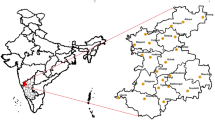Abstract
With the growing understanding of the role of radon and its daughter products as major sources of radiation exposure, the importance of large number of estimation of radon concentration in various parts of the country is realized. Inhalation of radon, thoron and their decay products is the major source of the total radioactive dose received by the human population from natural radiation. The indoor radon and thoron progeny levels in Nalbari area of Assam are studied by using the LR-115 (type II) Solid State Nuclear Track Detector in Plastic Twin Chamber dosimeter. Radon and thoron progeny levels in different types of dwellings for one full calendar year are presented in this paper. For Assam Type (A.T.) houses, indoor radon progeny concentrations vary from 0.17 to 0.64 mWL with an annual geometric mean of 0.27 mWL and that for Reinforced Cement Concrete (R.C.C.) houses vary from 0.22 mWL to 0.60 mWL with the annual geometric mean of 0.37 mWL. The thoron progeny levels in A.T. houses also vary from 0.01 to of 0.05 mWL with an annual geometric mean of 0.02 mWL and that for R.C.C. houses vary from 0.02 to 0.08 mWL with the annual geometric mean of 0.04 mWL.
Similar content being viewed by others
References
UNSCEAR United Nations Scientific Committee on the effects of Atomic Radiations: source and effects of inonizing radiations 73 (1993)
K K Narayanan, D N Krishnan and M C Subba Ramu Indian Association for Radiation Protection (ISRP), ISRP (k)-BR-3 (1992)
T V Ramachandran and M C Subba Ramu Control methods of radon and its progeny concentration in indoor atmosphere. Government of India, Atomic Energy Commission, BARC-1498, 7 (1990)
P C Deka, B Bhattacharjee, B K Sarma and T D Goswami Indian J. Env. Prot. 21 24 (2001)
P C Deka, Subir Sarkar, B K Sarma, T D Goswami, T V Ramachandran and K S V Nambi Indoor Built Environ. 12 343 (2003)
P C Deka, Subir Sarkar, B Bhattacharjee, T D Goswami, B K Sarma and T V Ramachandran Radiat. Meas. 36 431 (2003)
S A Durrani and R K Bull Solid State Nuclear Track Detection, Principles, Methods and Application. International Series in Natural Philosophy (Oxford: Pergamon Press) 111 169 (1998)
Y S Mayya, K P Eappen and K S V Nambi 12th National Symposium on Radiation Physics (1998)
Author information
Authors and Affiliations
Corresponding author
Rights and permissions
About this article
Cite this article
Deka, P.C., Sarma, H., Sarkar, S. et al. Study of indoor radon and thoron progeny levels in surrounding areas of Nalbari, Assam, India. Indian J Phys 83, 1025–1030 (2009). https://doi.org/10.1007/s12648-009-0063-6
Published:
Issue Date:
DOI: https://doi.org/10.1007/s12648-009-0063-6




